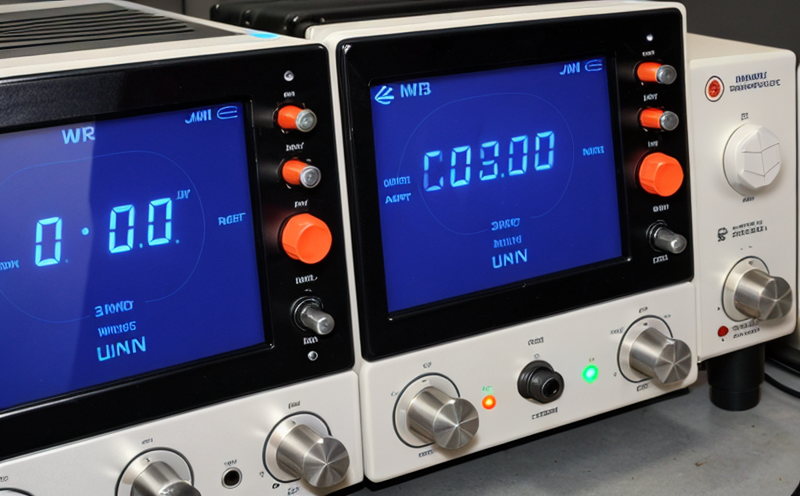ASTM D4935 RF Shielding Effectiveness Testing of IoT Enclosures
The ASTM D4935 standard is a critical benchmark for ensuring the reliability and performance of IoT enclosures in smart home environments. This testing ensures that electronic devices are adequately shielded from electromagnetic interference (EMI) and radio frequency (RF) radiation, which can degrade their functionality or cause malfunctions.
The ASTM D4935 standard focuses on the evaluation of RF shielding effectiveness by measuring how well a structure attenuates EM fields. This is particularly crucial in IoT devices like smart thermostats, security systems, and home automation hubs that depend on robust radio frequency performance to function optimally.
During testing, specimens are subjected to controlled RF environments where the amount of signal leakage through an enclosure is measured. The goal is to verify that any emitted or received signals do not exceed predefined thresholds set by regulatory bodies such as FCC, CE, and others.
The ASTM D4935 process involves several steps including preparation of the specimen, placement in a test chamber with controlled RF conditions, measurement of signal strength before and after enclosure exposure, and analysis of the results. Proper interpretation ensures compliance with international standards which is essential for market access and product safety.
Understanding the importance of ASTM D4935 testing helps companies ensure that their IoT devices meet stringent quality control criteria. This not only enhances consumer trust but also prevents potential hazards associated with poor RF shielding in sensitive electronic environments.
| Step | Description |
|---|---|
| Preparation | The specimen is prepared according to ASTM D4935 guidelines, ensuring it represents the actual product design. |
| Testing Environment Setup | A controlled RF testing chamber with calibrated equipment is set up to simulate real-world conditions. |
| Signal Measurement | The signal strength is measured both inside and outside the enclosure using appropriate instruments. |
| Data Analysis & Reporting | The results are analyzed against ASTM D4935 criteria, providing detailed reports on shielding effectiveness. |
Scope and Methodology
The ASTM D4935 standard establishes the framework for testing RF shielding effectiveness of IoT enclosures. The scope includes various types of enclosures used in smart home applications, such as those housing wireless routers, smart speakers, and other connected devices.
| Step | Description |
|---|---|
| Preparation | The specimen is prepared according to ASTM D4935 guidelines, ensuring it represents the actual product design. |
| Testing Environment Setup | A controlled RF testing chamber with calibrated equipment is set up to simulate real-world conditions. |
| Signal Measurement | The signal strength is measured both inside and outside the enclosure using appropriate instruments. |
| Data Analysis & Reporting | The results are analyzed against ASTM D4935 criteria, providing detailed reports on shielding effectiveness. |
Industry Applications
- Surefire compliance with regulatory requirements for IoT devices.
- Absence of interference in smart home systems, ensuring optimal performance.
- Enhanced security by preventing unauthorized access through electromagnetic channels.
- Improved reliability and longevity of electronic components within the enclosure.
The ASTM D4935 standard is vital for various industries including consumer electronics, telecommunications, and automotive. By ensuring that enclosures meet rigorous RF shielding standards, these sectors can mitigate risks associated with EMI, thereby enhancing overall product quality and user satisfaction.
| Industry | Application |
|---|---|
| Consumer Electronics | Ensuring seamless connectivity and signal integrity in smart home devices. |
| Telcommunications | Avoiding interference in network infrastructure to maintain stable communication. |
| Automotive | Preventing EMI from affecting critical vehicle systems like braking and steering. |
Competitive Advantage and Market Impact
- Enhanced market credibility through compliance with international standards.
- Increased consumer confidence leading to higher sales volumes.
- Reduced risk of product recalls due to non-compliance or malfunction issues.
- Premature obsolescence prevention by ensuring long-term performance and reliability.
Adopting ASTM D4935 RF shielding effectiveness testing offers significant advantages in the competitive market. It ensures that products meet stringent quality control criteria, thereby enhancing consumer trust and satisfaction. This can translate into increased sales and brand loyalty. Moreover, it helps companies avoid costly recalls and reputational damage associated with non-compliant or faulty products.





